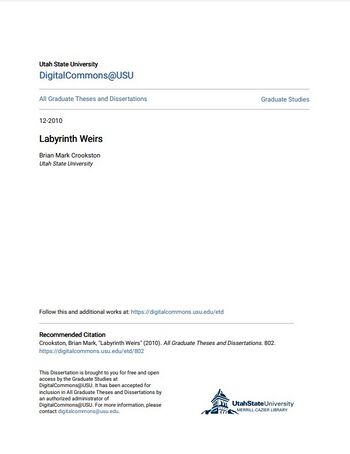Labyrinth Weirs, Dissertation by Brian Crookston
Utah State University, 2010

Labyrinth weirs are often a favorable design option to regulate upstream water elevations and increase flow capacity; nevertheless, it can be difficult to engineer an optimal design due to the complex flow characteristics and the many geometric design variables of labyrinth weirs. This study was conducted to improve labyrinth weir design and analyses techniques using physical-model-based data sets from this and previous studies and by compiling published design methodologies and labyrinth weir information.
A method for the hydraulic design and analyses of labyrinth weirs is presented. Discharge coefficient data for quarter-round and half-round labyrinth weirs are offered for 6° ≤ sidewall angles ≤ 35°. Cycle efficiency is also introduced to aid in sidewall angle selection. Parameters and hydraulic conditions that affect flow performance are discussed. The validity of this method is presented by comparing predicted results to data from previously published labyrinth weir studies.
A standard geometric design layout for arced labyrinth weirs is presented. Insights and comparisons in hydraulic performance of half-round, trapezoidal, 6° and 12° sidewall angles, labyrinth weir spillways located in a reservoir with the following orientations are presented: Normal, Inverse, Projecting, Flush, Rounded Inlet, and Arced cycle configuration. Discharge coefficients and rating curves as a function of HT/P are offered. Finally, approaching flow conditions and geometric similitude are discussed; hydraulic design tools are recommended to be used in conjunction with the hydraulic design and analysis method.
Nappe aeration conditions for trapezoidal labyrinth weirs on a horizontal apron with quarter- and half-round crests (6° ≤ sidewall angle ≤ 35°) are presented as a design tool. This includes specified HT/P ranges, associated hydraulic behaviors, and nappe instability phenomena. The effects of artificial aeration (a vented nappe) and aeration devices (vents and nappe breakers) on discharge capacity are also presented. Nappe interference for labyrinth weirs is defined; the effects of nappe interference on the discharge capacity of a labyrinth weir cycle are discussed, including the parameterization of nappe interference regions to be used in labyrinth weir design. Finally, the applicability of techniques developed for quantifying nappe interference of sharp-crested corner weirs is examined. (222 pages)
Revision ID: 7696
Revision Date: 09/28/2023
